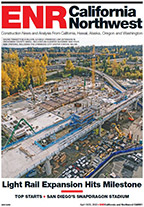The good news is that the baseline contract value of projects in the region's Top Starts rankings rose to $127 million last year, more than double that of 2010. The not-so-good news is that the combined total of the 25 projects in the rankings only reached $7.9 billion, a 10% decline from 2010 and down 58% from the $18.6 billion posted in 2009.
The decline is in line with the latest data from McGraw-Hill Research & Analytics. It shows that 2011 total starts for the entire New York, New Jersey and Connecticut region fell 14% from 2010, to about $38 billion. The regional industry, like the national market, continues to bounce along the bottom, analysts say.
However, this year's rankings, which represent projects that initially broke ground last year, span a wide range of work—from the $1.2-billion redevelopment at New York City's John F. Kennedy Airport to the $127-million Courtyard and Residence Inn Hotel project in Manhattan. The rankings include a nearly even mix of public and private projects and are dominated by the transportation and institutional sectors.
"I wouldn't say we are in any great revival right now. Things are moving very slow out there," says Robert Reager, president of Joseph Jingoli & Son, Lawrence-ville, N.J. His firm did preconstruction work related to the Hudson Transmission Line project (p. 18), No. 2 in the rankings. Reager says that Jingoli's energy projects are moving ahead but that the region's overall construction market remains sluggish.
"You could say that some of the projects to break ground last year have worked their way through the system, after being in the planning stages for a while, Reager says. "They just wound up starting last year."
That is how analysts view the strong showing in the rankings for transportation projects, with MTA Capital Construction Co. accounting for four of the projects in the rankings. All four are portions of mega-projects—the Second Avenue Subway, East Side Access and the No. 7 Subway line extension.
All three states have transportation projects in the rankings. The Connecticut Dept. of Transportation is rebuilding the New Haven interchange to accommodate lanes from the new Pearl Harbor Memorial Bridge, a massive construction project set for completion in 2015; ConnDOT is also in the second phase of reconstructing the Moses Wheeler Bridge in Stratford. The New Jersey Turnpike Authority is reconstructing the Easterly Hackensack River Bridge Deck.
Transportation experts say that the bidding environment for jobs has been in their favor. While they hope to take advantage of this going forward, they say future transportation projects depend largely on what happens in Washington, where the House and Senate are considering separate highway transportation bills. The House American Energy and Infrastructure Jobs Act is a five-year plan that includes $260 billion worth of transportation measures; the Senate's two-year proposal is a $109-billion, transportation-only bill.
"We are kind of holding our breath to see what will happen [in Congress] because what the funding level is there will tell us what our program will be," says Mark Rolfe, ConnDOT District No. 3 engineer, who is working on the New Haven interchange. "The [state transportation] department's capital program depends on a number of factors, but the biggest source of revenue is the federal transportation program. Not knowing what will happen there makes it difficult to know how much we can do."
The institutional sector, including the recreational, dormitory, education and health-care divisions, also made a strong showing in the rankings. Leading the sector is the New York State Lottery's $510-million Resorts World in Queens, No. 4 in the rankings. The project includes renovation and additions to accommodate 4,500 video lottery terminals.
The institutional sector "has been a source of strength for the New York City construction market and shows no signs of abating," says Richard Anderson, president of the New York Building Congress. Many New York educational institutions have already started work or have plans on the drawing board, he adds. Several of these are in the rankings, including the $366-million expansion at Albany University's College of Nanoscale Science and Engineering. That project, the latest in a series, will include nearly 500,000 sq ft of infrastructure and 50,000 sq ft of cleanrooms.
In the health-care sector, Danbury Hospital's $150-million, 300,000-sq-ft North Tower is No. 22 in the rankings. The project aims to achieve LEED-Silver or Gold status (ENR New York 12/12/11 p. 16).
Only two projects in the commercial sector, which includes hotels, garages and office towers, made the rankings and both are in New York City. Besides the Courtyard and Residence Inn project, the New York Dept. of Sanitation is building the $195-million New Manhattan Community District's 1/2/5 Garage and UPS Distribution Center.
McGraw-Hill Research data shows that this sector fell 4%, to $6 billion last year in the tristate region. The data shows that the region's hotel starts rose 77%, to $922 million, but that this was not enough to offset a 15% dip in garages and service structures as well as a 24% dip in office buildings.
No office towers made this year's rankings, and the office tower sector was down in New York City as well, Anderson says. "That's a real problem. The reason you don't have them is because jobs are not growing sufficiently," he says. "We've had 20 office projects on the drawing board over the last few years—ready to go once the developers feel they have sufficient tenancy to justify construction."
All three of the residential towers on the rankings list this year, however, are in New York City. The largest of these is the $362-million Gotham West, No. 6 on the list. The mixed-use Gotham development consumes nearly an entire city block between W. 44th and W. 45th streets and 10th and 11th avenues, with the residential portion of the project consisting of a 31-story tower and two, 14-story structures.
The tristate's total residential sector inched up just 1% in 2011, to $8.7 billion, according to McGraw-Hill Research. In New York City, however, this sector jumped 24% last year, to $2.9 billion.
"We went from 33,000 units authorized in 2008 to 6,000 in 2009," Anderson says. "The residential market is hot again."
Energy projects also made a strong showing in the rankings this year. These include the Hudson Transmission Line that will run from Ridgefield, N.J., to New York City, as well as two peaking station projects from a unit of this year's Owner of the Year, PSEG.
One alternative energy project has made headlines: BP Solar and Met Life's 32-MW solar energy farm, hosted on the Dept. of Energy's Brookhaven National Laboratory's (BNL) site in Upton, N.Y. The project is North America's third-largest photovoltaic system and the second-largest built last year, behind the Copper Mountain Solar Facility in Boulder City, Nev., says Richard Chandler, BP Solar project developer.
Long Island Power Authority will purchase energy from the farm, and BNL will study how weather patterns in the Northeast affect the operation, says a BNL spokesman. The project, he adds, consists of 164,312 solar panels and boasts the smallest footprint for a solar array of its output.
Delta's New Terminal 4 Prepares for Takeoff
When Delta Airline’s Terminal 3 at New York’s John F. Kennedy Airport first opened as the Pan Am Worldport in 1960, it was never intended to hold the amount of traffic that it currently does.
But a joint venture of Turner Construction, New York, and Peter Scalamandre & Sons Inc., Freeport, N.Y., along with Lend Lease, has begun to address that by expanding the 1.3-million-sq-ft terminal by 480,000 sq ft to create the international Terminal 4. The $1.2-billion project, No. 1 in this year’s rankings, broke ground in January 2011 and includes two phases. Phase 1A includes work on an existing nine-gate concourse, taxi lanes and baggage claim. There are about 500 construction workers on site at present, but that number is expected to increase to 700 by the spring to ensure the project remains on track for completion in May 2013, says Neil Jensen, Turner project executive.
“The logistics of organizing the construction is the biggest piece of the puzzle,” says Harry Olsen, Delta Airlines project director. “The cooperation of Delta, the Port Authority and JFK International Airport Terminal has been second to none.”












Post a comment to this article
Report Abusive Comment